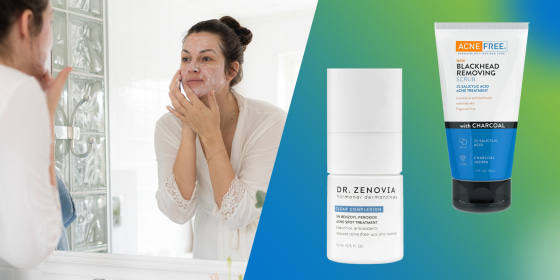
How to treat and prevent adult acne, according to dermatologists
Adult acne is more common than you might think — we spoke to dermatologists about the ingredients that help fight and prevent breakouts.




Ilyas recommended this face moisturizer from La Roche-Posay, explaining that it’s soothing, applies easily and hydrates the skin. According to the brand, it offers 48-hour hydration and can be used on the neck and hands in addition to the face. Its hero ingredient is niacinamide, which Ilyas noted is hydrophilic, meaning it loves water or moisture. The ingredient is also "anti-inflammatory and features anti-itch properties as well as antimicrobial activity," she said, which can help those dealing with these as a side effect of inflamed breakouts.
Board-certified dermatologist Dr. Eileen Deignan previously recommended the Neutrogena Oil-Free Acne Wash to Select, deeming it her top choice for a salicylic acid acne-fighting product. It contains a 2 percent concentration of salicylic acid, and the brand says it cleanses away dirt and oil that can build up over time. Neutrogena also says it's oil-free, residue-free, and non-comedogenic.
This concentrated formula uses 5 percent benzoyl peroxide to curb hormonal flare-ups and reduce the risk of future blemishes, according to the brand. It also contains medical-grade aloe vera that the brand says helps to soothe hormonally imbalanced skin.
If your issue is blackheads and whiteheads, this pick from AcneFree is a good option. It contains both charcoal and 2 percent salicylic acid, which work to whisk away pore-clogging oil, dirt, and debris, according to the brand.
Select editor Morgan Greenwald — who often struggles with hormonal breakouts — is a big fan of this cleansing balm from Peace Out, which is formulated with salicylic acid, niacinamide and hyaluronic acid. According to the brand, the balm minimizes the appearance of pores plus moisturizes the skin, preparing it for the other products in your skin care routine.
Zeichner said dermatologists still don’t quite understand exactly why acne develops in adulthood, but it likely has to do with hormones, diet and stress. "Hormonal fluctuations stimulate oil glands, increasing sebum production and promoting inflammation in the skin," he explained. "This explains the cyclical breakouts that women typically get around the time of their period."
When it comes to diet, Zeichner explained that certain dairy products like skim milk and foods with a high glycemic index are associated with acne breakouts. Several studies have also found a link between stress and excess sebum production, which can lead to breakouts.
"The same hormones that prepare our bodies for stress also stimulate our oil glands," Zeichner explained. "CRH, known as corticotropin releasing hormone, is responsible for increasing cortisol as part of our flight or fight response. At the same time, it has a direct effect on sebaceous glands."
When it comes to treating acne, there are two main over-the-counter ingredients to look out for: benzoyl peroxide and salicylic acid. "Benzoyl peroxide helps lower levels of acne-causing bacteria on the skin while salicylic acid helps to remove excess oil and dead cells from the skin that may contribute to blockages of the pores," explained Zeichner. Other ingredients Ilyas recommended seeking out are azelaic acid (to clear acne-causing bacteria from pores), niacinamide (to regulate oil and reduce inflammation associated with acne) and hyaluronic acid (to soothe redness and hydrate the skin).
Ilyas recommended taking a "less is more" approach if you're on the quest to combating adult acne. "Many of my patients figure this out the hard way after spending money on numerous products only to find out that they either do not help or they just make [the condition] worse," she said.
Ilyas also noted you may want to avoid makeup wipes, as they can be drying, irritating and/or aggravating on skin that's experiencing adult acne. Instead, she suggested using just soap and water or micellar water on a cotton round to remove makeup.
Ultimately, Ilyas said that adult acne presents itself as inflamed comedones or clogged pores with a potentially cystic component, and it can be treated like most other acne.
Catch up on Select's in-depth coverage of personal finance, tech and tools, wellness and more, and follow us on Facebook, Instagram and Twitter to stay up to date.